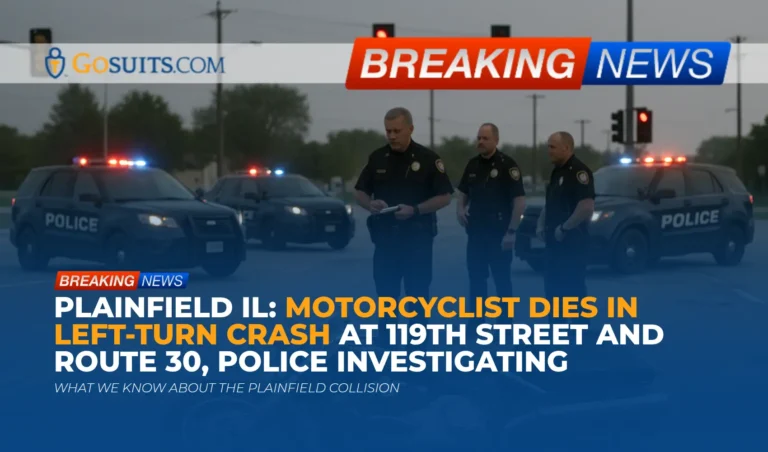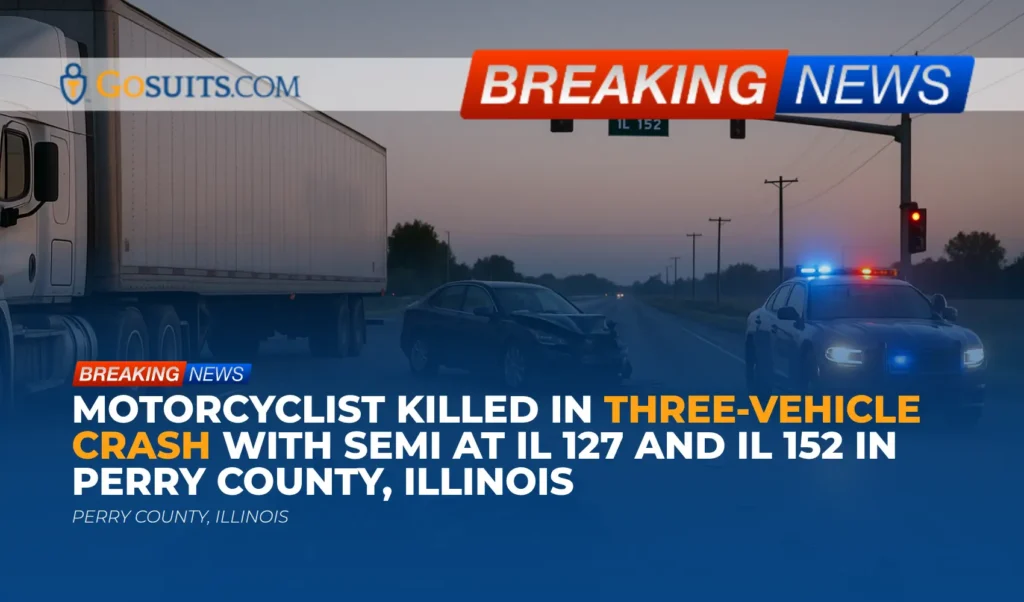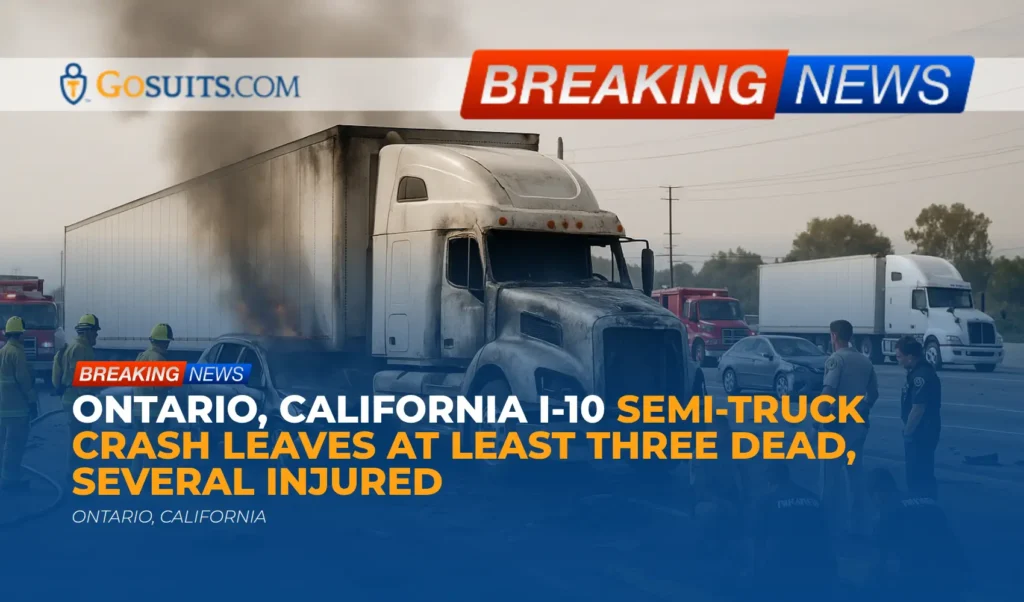- What We Know About the Plainfield Collision
- Location, Time, and Agencies Responding
- Why Left-Turn Crashes Are So Dangerous for Motorcyclists
- Illinois Rules on Left Turns and Right of Way
- What Happens During a Fatal Crash Investigation
- How Families Can Obtain Official Records and Updates
- Potential Civil Liability and Insurance Considerations
- Preserving Evidence After a Serious Crash
- Time Limits That May Apply in Illinois Civil Cases
- Community Safety and Engineering Considerations at 119th Street and Route 30
- Where to Find Support and Practical Help
- Commentary from Gosuits Plainfield, Illinois Personal Injury Attorney
- What Action Makes Sense Now
What We Know About the Plainfield Collision
According to Plainfield police, a motorcyclist died on Friday morning after a two-vehicle crash at the intersection of 119th Street and Route 30 in Plainfield. The preliminary information shared publicly states that a 2025 Harley Davidson motorcycle was traveling north on Route 30 when a black 2023 Chevrolet Malibu, traveling south on Route 30, attempted a left turn onto 119th Street and failed to yield the right of way. The collision occurred at approximately 6:05 a.m. The rider was transported to Rush Copley Medical Center, where he was pronounced deceased. Officials have not yet released the man’s identity pending notification of next of kin. The driver of the Chevrolet remained at the scene and is cooperating with the investigation. Police reported no additional injuries. The intersection was temporarily closed for scene reconstruction by Plainfield police with assistance from the Illinois State Police. Anyone with information was asked to contact Sgt. Dino Dabezic at 815-267-7238.
We extend our sincere condolences to those mourning this loss. Sudden, early-morning crashes like this often leave families with many unanswered questions while they navigate notifications, official reports, and the first steps of practical and legal decisions. The information below is intended to help explain what typically happens next, how evidence is documented, what Illinois law says about left turns and right of way, and how families can obtain records respectfully and efficiently.
Location, Time, and Agencies Responding
The collision occurred at the signalized intersection of 119th Street and Route 30 in Plainfield at about 6:05 a.m. on a weekday morning. This is a busy commuter corridor, and lighting and traffic flow at that hour can involve a mix of dawn conditions, school traffic, and work commutes. The Plainfield Police Department responded, secured the area, and coordinated with the Illinois State Police for crash reconstruction. Temporary road closures are standard in fatal collisions to allow for careful documentation, measurements, and preservation of physical evidence.
Reconstruction typically includes mapping the roadway, photographing final rest positions of the vehicles, documenting skid and yaw marks, collecting vehicle damage profiles, and noting signal timing and sightlines. These steps help investigators understand speeds, direction of travel, and decision points. While early statements reference a failure to yield by the left-turning car, agencies often emphasize that all conclusions are preliminary until the reconstruction and report review are complete.
Why Left-Turn Crashes Are So Dangerous for Motorcyclists
National crash data consistently show elevated risk to motorcyclists when another vehicle turns left across their path. The combination of smaller motorcycle profiles, driver gap estimation errors, and speed dynamics can create high-severity impacts. In its motorcycles safety facts report, the National Highway Traffic Safety Administration has reported that a substantial portion of fatal two-vehicle motorcycle crashes involve another vehicle turning left while the motorcycle is going straight. See NHTSA’s Traffic Safety Facts: Motorcycles for national trends and factors that contribute to these scenarios at NHTSA crash stats.
Important context for families includes:
- Visibility challenges: Motorcycles present a smaller visual target, and drivers sometimes misjudge distance and speed when turning left across oncoming traffic.
- Short time-to-collision: At arterial speeds, even a minor miscalculation in gap acceptance can leave the rider with little room to brake or evade.
- Injury severity: Riders lack the structural protection of a car, so impacts to the front of a motorcycle can be catastrophic even at moderate speeds.
Illinois-specific crash data and roadway safety resources are available from the Illinois Department of Transportation, including annual crash facts and statewide safety initiatives at IDOT safety.
Illinois Rules on Left Turns and Right of Way
Illinois law requires drivers turning left to yield to oncoming traffic that is so close as to constitute an immediate hazard. The statute addressing left turns at intersections is part of the Illinois Vehicle Code. The relevant section provides that the driver of a vehicle intending to turn left must yield the right-of-way to any vehicle approaching from the opposite direction which is so close as to constitute an immediate hazard. See 625 ILCS 5/11-902 at the Illinois General Assembly website: Illinois left-turn yielding.
Key takeaways from Illinois traffic law in this context:
- Right of way is not absolute: Even with a green light, turning drivers must ensure the turn can be made safely without impeding oncoming traffic.
- Signal indications matter: Protected left-turn arrows differ from permissive left-turn indications; investigators often review signal timing and phasing to understand what each driver faced.
- Civil versus traffic consequences: Whether or not a traffic citation is issued, civil liability is a separate question governed by negligence standards in civil court.
What Happens During a Fatal Crash Investigation
After a fatal traffic incident, several processes run in parallel. Families often interact with multiple agencies, each with a different role:
- Local police investigation: The responding department secures the scene, interviews witnesses, documents physical evidence, and prepares a crash report. They may coordinate with state police reconstruction teams for measurements and analysis.
- State police reconstruction: Specialists assist with technical reconstruction, using measurements, vehicle damage analysis, and sometimes event data recorders to build a picture of pre-impact speeds, trajectories, and driver actions.
- Coroner’s office: The county coroner is responsible for determining cause and manner of death and may conduct an autopsy. The coroner notifies next of kin and issues documentation needed later for insurance, probate, and civil claims.
Timelines vary. Preliminary findings may be available within days or weeks, while full reconstruction reports can take longer. Families can request updates and copies of reports once they are releasable under Illinois law. Some records may be withheld temporarily if their release would compromise an ongoing investigation.
How Families Can Obtain Official Records and Updates
Obtaining accurate records helps answer questions and is often necessary for insurance and potential civil claims. The following public sources are commonly involved. When in doubt, ask the agency what is available and what documentation they need from you. Consider consulting a lawyer before making record requests if you have concerns about how your statements might be used later.
Plainfield Police Department crash report and updates
- Point of contact: Sgt. Dino Dabezic at 815-267-7238, as noted by police. This is an appropriate starting point for tips or to ask how and when reports will be released.
- Requesting reports: Illinois public bodies process document requests under the Illinois Freedom of Information Act, 5 ILCS 140. See the statute at Illinois FOIA. The department can advise whether to make a FOIA request or a standard records request once the report is finalized.
Illinois State Police crash reports
- Availability: Some Illinois crash reports can be requested through the Illinois State Police portal once processed. See ISP Crash Reports.
- What to have ready: Date, location, and the agency report number, if available, help locate the report.
Will County Coroner’s Office
- Role: The coroner determines cause and manner of death, oversees autopsies, and provides reports to next of kin and authorized parties.
- Records: Families can typically request the coroner’s report and, when appropriate, autopsy and toxicology reports. Processing times vary based on laboratory testing.
- Where to start: See the Will County Coroner’s official page for contact details and instructions. You can reach it via the Will County government website at Will County Government and navigate to the Coroner’s Office.
Death certificates
- Why needed: Insurers, financial institutions, and courts often require certified death certificates.
- How to obtain: The Illinois Department of Public Health maintains guidance on obtaining death records at IDPH death records. Local county clerks may also provide certified copies.
911 audio, CAD logs, and dispatch records
- Usefulness: These can show call timing, dispatch notes, and response intervals.
- How to request: Typically via FOIA to the relevant dispatch center or police department. See Illinois FOIA at Illinois FOIA.
Traffic signal timing and camera footage
- Signal timing: If the intersection is on a state route such as Route 30, signal timing and maintenance records may be held by the Illinois Department of Transportation District 1. See IDOT District 1.
- Footage: Some intersections have cameras for traffic monitoring. Availability varies, and retention can be short. Prompt written requests improve the chance of preservation.
Medical records
- What to request: Emergency department records and EMS run sheets can be important for understanding medical findings. Hospitals will explain who may request records and what authorizations are required.

Towing and vehicle preservation
- Why it matters: Vehicles can contain critical evidence, including crash data modules and impact patterns.
- Practical step: Ask the investigating agency where the vehicles were towed and what holds are in place. Consider having counsel send preservation notices to prevent disposal or repair before inspection.
Potential Civil Liability and Insurance Considerations
While the investigation is ongoing, the facts shared publicly point to a left-turn failure to yield. In Illinois civil cases, liability generally turns on negligence, which considers whether a driver breached a duty of reasonable care and whether that breach caused harm.
Negligence elements in a roadway crash
- Duty: All drivers have a duty to follow traffic laws and use reasonable care under the circumstances.
- Breach: A failure to yield when turning left into the path of oncoming traffic can be evidence of a breach of duty. See 625 ILCS 5/11-902 at Illinois left-turn yielding.
- Causation and damages: The breach must be a proximate cause of the harm. Damages in fatal cases are addressed through specific Illinois statutes discussed below.
Comparative negligence in Illinois
Illinois follows a modified comparative fault system. An injured party’s damages can be reduced by their percentage of fault, and recovery is barred if their fault is more than 50 percent. See 735 ILCS 5/2-1116 at Illinois comparative fault. Allocation of responsibility is fact-dependent and often informed by reconstruction, witness statements, and physical evidence.
Wrongful death and survival claims
- Wrongful Death Act: Provides a civil claim for the benefit of survivors for losses resulting from a death caused by wrongful act or neglect. See 740 ILCS 180 at Illinois Wrongful Death Act.
- Survival Act: Allows certain claims the decedent could have brought, to survive in the decedent’s estate. See 755 ILCS 5/27-6 at Illinois Survival Act.
- Personal representative: These claims are typically brought by the personal representative of the estate, appointed through probate.
Insurance layers that may be implicated
- At-fault driver’s liability coverage: Illinois requires minimum auto liability insurance. See the Secretary of State’s overview at Illinois mandatory insurance.
- Underinsured motorist coverage: If available on the rider’s policy, it may apply if the at-fault driver’s coverage is insufficient.
- Employer coverage: If either driver was in the course of employment, an employer’s policy could come into play. This depends on verified facts.
Insurers typically open liability and coverage investigations promptly. Statements given to any insurer can be used later, so it is prudent to consult a lawyer first, understand rights and obligations, and prepare before speaking with adjusters.
Preserving Evidence After a Serious Crash
Evidence preservation is critical and time-sensitive. Many important items can be lost quickly if not secured. Practical steps often include:
- Preservation letters: Written notices to involved parties and their insurers asking them to preserve vehicles, data, and documents.
- Vehicle inspections: Coordinated inspections of the motorcycle and car, including photographs, measurements, and downloading any available event data recorder information.
- Intersection information: Requests for traffic signal timing charts, maintenance logs, and any available camera footage from transportation agencies.
- Witness follow-up: Locating and interviewing witnesses while memories are fresh and before contact information changes.
- Rider gear and equipment: Preserving helmets, jackets, and other gear can help analyze impact forces and mechanisms of injury.
If a civil claim is anticipated, early involvement of counsel can help ensure preservation efforts are properly directed and documented.
Time Limits That May Apply in Illinois Civil Cases
Illinois law imposes filing deadlines that vary based on the type of claim and the identity of potential defendants. These are general timeframes; specific circumstances and exceptions can alter them, so confirm what applies in any particular matter.
- Wrongful death: Generally must be filed within 2 years of the death. See 740 ILCS 180/2 referenced via the Wrongful Death Act at Illinois Wrongful Death Act.
- Personal injury: Typically 2 years from the date of injury for negligence claims, under Illinois’ general limitations provisions.
- Claims against local public entities: Illinois’ Local Governmental and Governmental Employees Tort Immunity Act provides a 1-year limitation period for civil actions against local public entities and their employees, with limited exceptions. See 745 ILCS 10/8-101 at Tort Immunity Act limitations.
Because identifying all potentially responsible parties can take time, it is wise to address deadlines early, gather records promptly, and review how the statutes apply to the facts.
Community Safety and Engineering Considerations at 119th Street and Route 30
Intersections like 119th Street and Route 30 serve high volumes of traffic and multiple turning movements. After serious collisions, transportation agencies may review whether existing traffic controls are functioning as designed and whether any operational or engineering improvements could reduce crash risk. Examples of measures sometimes evaluated for similar intersections include protected-only left-turn phasing where warranted, improved signal visibility, enhanced lighting in early morning hours, and access management to reduce conflict points. Any changes would follow engineering study, standards, and warrants.
Route 30 is a state highway under the Illinois Department of Transportation. Questions about signal timing, maintenance, or roadway configuration can be directed to IDOT District 1, which covers Will County. General information is available at IDOT District 1. Broad safety resources and statewide crash data are available at IDOT safety.
Where to Find Support and Practical Help
Navigating the days and weeks after a fatal crash is overwhelming. The following resources may help with information, documentation, and immediate support. Availability can depend on eligibility and agency policies, and some services are informational rather than counseling.
- Plainfield Police Department: For updates and to share information with investigators, contact the department and, as noted publicly, Sgt. Dino Dabezic at 815-267-7238.
- Will County Coroner’s Office: For information about the death investigation, autopsy status, and how to request reports. Visit the county’s main site at Will County Government and navigate to the Coroner.
- Illinois State Police crash reports: To check whether a report is available through state channels, use the portal at ISP Crash Reports.
- Illinois Department of Public Health: For guidance on obtaining certified death certificates, see IDPH death records.
- Illinois FOIA: If you need to request public records from law enforcement or transportation agencies, review the process at Illinois FOIA.
- Transportation information: For questions about state-maintained signals and roadways in the area, see IDOT District 1.
- Emotional support: The national SAMHSA helpline provides free, confidential treatment referral and information for mental health needs, 24/7. See SAMHSA National Helpline.
If insurance carriers contact you early, it is reasonable to ask for time, get knowledgeable guidance, and avoid recorded statements until you feel prepared. What is said in these conversations can be used later in ways that are not always obvious at the outset.

Commentary from Gosuits Plainfield, Illinois Personal Injury Attorney
We are deeply sorry for the loss reported in this Plainfield crash. A sudden death on the roadway changes lives in an instant, and families deserve clear information, patience, and respect as they face difficult steps. The discussion here is for general educational purposes and is not a substitute for tailored guidance about any particular situation.
From a personal injury perspective, the publicly shared facts point to a familiar and tragic pattern: a left-turning vehicle failing to yield to an oncoming motorcyclist. Illinois law is explicit about left-turn yielding obligations, and reconstruction typically focuses on timing, visibility, and whether the turning driver could have waited for a safe gap. The involvement of state reconstruction specialists suggests careful measurements are underway to answer these questions.
In the aftermath of a fatal crash, insurance companies move quickly. Liability adjusters may seek early statements, ask pointed questions, or request authorizations that allow broad access to records. Corporations and insurers have well-developed processes and resources that can overwhelm people during a vulnerable time. Without full context, a seemingly harmless answer can be used to dispute fault, downplay loss, or narrow coverage. Taking a pause to understand rights, the likely scope of insurance, and the value of preserving evidence helps level the playing field.
There is value in a free consultation before contacting any insurance carrier. It provides a chance to review the known facts, discuss potential claims under Illinois wrongful death and survival laws, and plan how to secure key records and preserve vehicles and data. Early, thoughtful steps can reduce uncertainty and help ensure that important details are not lost.
What Action Makes Sense Now
- Gather the essentials: Secure the incident date, location, agency case number, and the contact name provided by police. These details streamline requests for records and prevent delays.
- Preserve evidence promptly: Vehicles, onboard data, and traffic footage can be altered or lost quickly. Written preservation requests and timely outreach to agencies and tow yards can make a meaningful difference.
- Be cautious with insurers: Adjusters often call early. Speaking before understanding rights can affect fault allocations and coverage decisions. Preparing first can prevent missteps.
- Track deadlines: Illinois has time limits for filing civil claims, with shorter timelines for certain public entities. Starting the review process early ensures adequate time to identify all potentially responsible parties.
- Request official records: Crash reports, coroner documents, and death certificates form the foundation for benefits, insurance, and any civil claims. Agencies will explain what’s available and when.
- Seek supportive services: Emotional support and clear information help people make sound decisions. Public resources can assist while formal reports are pending.
Acting sooner rather than later helps preserve options. Intersection footage and electronic vehicle data are often subject to short retention or change once repairs begin. Written preservation and a structured plan for record requests provide clarity at a time when it is most needed.
References
- 625 ILCS 5/11-902 Left turns
- 735 ILCS 5/2-1116 Comparative fault
- 740 ILCS 180 Illinois Wrongful Death Act
- 755 ILCS 5/27-6 Illinois Survival Act
- 745 ILCS 10/8-101 Tort Immunity Act limitations
- Illinois State Police Crash Reports portal
- Illinois Department of Public Health: Death records
- Illinois Secretary of State: Mandatory insurance
- IDOT safety resources
- IDOT District 1
- NHTSA Traffic Safety Facts: Motorcycles
- SAMHSA National Helpline
- Illinois Freedom of Information Act






